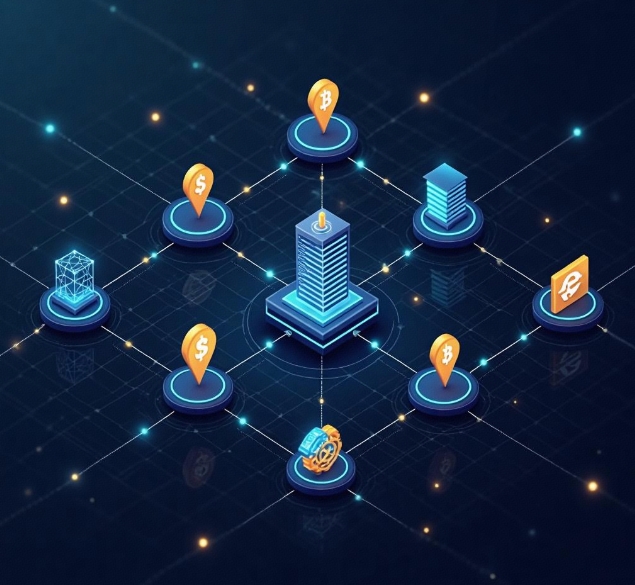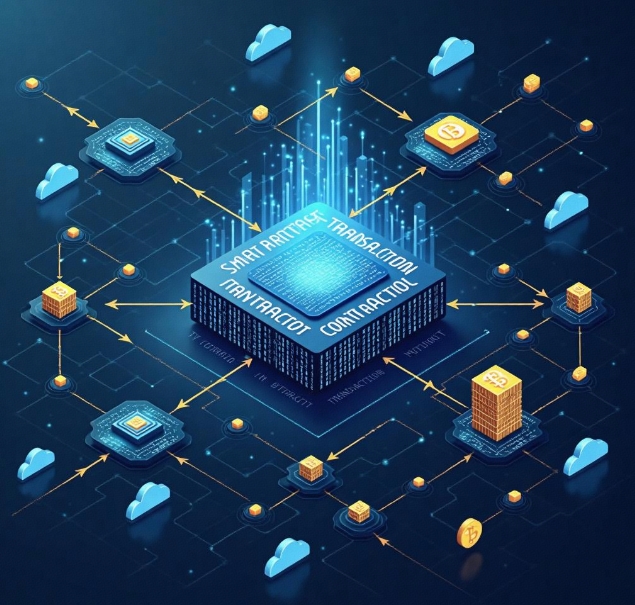How to choose a suitable blockchain platform for DApp development?
- latest articles
- 1.DApp Development & Customization: Merging Diverse Market Needs with User Experience 2.Analysis of the Core Technical System in DApp Project Development 3.How to achieve cross-chain interoperability in Web3 projects? 4.How does the tokenization of points reconstruct the e-commerce ecosystem? 5.How to Set and Track Data Metrics for a Points Mall? 6.What is DApp Development? Core Concepts and Technical Analysis 7.Inventory of commonly used Web3 development tools and usage tips 8.Development of a Distribution System Integrated with Social E-commerce 9.Six Key Steps for Businesses to Build a Points Mall System 10.What is DApp Development? A Comprehensive Guide from Concept to Implementation
- Popular Articles
- 1.Future Trends and Technology Predictions for APP Development in 2025 2.Analysis of the DeFi Ecosystem: How Developers Can Participate in Decentralized Finance Innovation 3.From Zero to One: How PI Mall Revolutionizes the Traditional E-commerce Model 4.DAPP Development | Best Practices for Professional Customization and Rapid Launch 5.Recommended by the Web3 developer community: the most noteworthy forums and resources 6.From Cloud Computing to Computing Power Leasing: Building a Flexible and Scalable Computing Resource Platform 7.How to Develop a Successful Douyin Mini Program: Technical Architecture and Best Practices 8.Shared Bike System APP: The Convenient Choice in the Era of Smart Travel 9.How to Create a Successful Dating App: From Needs Analysis to User Experience Design 10.From Design to Development: The Complete Process of Bringing an APP Idea to Life
With the rapid development of blockchain technology, decentralized applications (DApps) have become an important component of the digital world. Whether in finance, gaming, social networks, or supply chain management, the application scenarios for DApps are increasingly diverse. Developing an efficient and scalable DApp requires choosing a suitable blockchain platform. This article will explore how to select the appropriate blockchain platform for DApp development based on factors such as project requirements, technical characteristics, and platform scalability.
I. Overview of DApp Development
Decentralized applications (DApps) are applications that run on a blockchain network and do not rely on traditional central servers to manage and store data. Compared to traditional applications, DApps offer higher security, privacy protection, and transparency. All operations are executed through smart contracts and recorded on the blockchain.
The basic components of a DApp include:
Frontend: The user interface, typically a web or mobile application.
Smart Contracts: Program logic running on the blockchain, responsible for handling the application's business logic.
Blockchain Network: Provides decentralized data storage and consensus mechanisms.
II. Factors to Consider When Choosing a Blockchain Platform
Choosing the right blockchain platform for DApp development is a complex decision-making process that involves multiple technical, economic, and security considerations. Here are some key factors:
1. Platform Scalability
When selecting a blockchain platform, the first consideration is its scalability. DApps may face high transaction and computational demands as user numbers grow, so the platform's ability to handle these pressures effectively is crucial. For DApps requiring high throughput (TPS) and low latency, platform scalability is particularly important.
For example, Ethereum, which uses a Proof of Work (PoW) consensus mechanism, has relatively low transaction throughput and can become congested when processing large volumes of transactions. In contrast, platforms like Solana, which employ a Proof of History (PoH) mechanism, can handle thousands or even tens of thousands of transactions per second, making them suitable for applications requiring high-frequency trading and low-latency responses.
2. Platform Security
The security of a blockchain platform is a critical factor in the selection process. DApp smart contracts often involve significant financial flows, and if contract vulnerabilities are exploited by hackers, substantial losses can occur. Therefore, platform security and smart contract auditing mechanisms are essential.
For instance, the Ethereum platform, as a widely adopted blockchain, has undergone years of testing and auditing for smart contract security. In comparison, Binance Smart Chain (BSC), while offering higher transaction throughput, may face more security challenges due to its relatively new ecosystem.
3. Development Language and Tool Support
The development languages and tools of a blockchain platform directly impact developer productivity and efficiency. For example, the smart contract development language for the Ethereum platform is Solidity, which has extensive documentation and tool support. Developers can use tools like Truffle and Hardhat for smart contract development, testing, and deployment.
However, platforms like NEO use more mainstream programming languages such as C# and Python, which are more familiar to developers. Other platforms like EOS and Tron have their own development languages and tools, so developers need to choose based on their team's technical stack and preferences.
4. Community Support and Ecosystem
The decentralized nature of blockchain makes the activity and support of its developer community very important. An active developer community can help quickly resolve issues during development and provide abundant resources and tools. Additionally, a robust ecosystem can offer more integration opportunities and a user base for your DApp.
For example, Ethereum has the world's largest blockchain developer community, extensive development support, and numerous open-source projects. Meanwhile, the Polkadot platform, through its cross-chain technology, offers greater interoperability, attracting many emerging DApp projects. Choosing a blockchain platform with active community support can significantly reduce development challenges.
5. Transaction Fees
Transaction fees are another critical factor to consider. Conducting transactions on a blockchain platform typically incurs fees, which can increase significantly during high-traffic periods, affecting user experience. For instance, Ethereum's Gas fees fluctuate widely and can become very expensive during network congestion, which may be problematic for DApps targeting mass users.
In contrast, platforms like Polygon and Binance Smart Chain offer lower transaction fees, making them suitable for low-cost, high-frequency transaction scenarios. When selecting a platform, it's essential to weigh transaction fees based on the DApp's target user base and transaction needs.
6. Smart Contract Functionality and Flexibility
Different blockchain platforms offer varying levels of support and functionality for smart contracts. Some platforms provide more flexible smart contract capabilities, allowing developers to implement more complex business logic. For example, Ethereum's smart contract functionality is very powerful, supporting various complex decentralized applications, including decentralized finance (DeFi) and NFT marketplaces.
Other platforms, such as EOS and Tron, offer simplified smart contract models suitable for less complex application requirements. Choosing the appropriate smart contract model based on the DApp's complexity and functional needs is crucial.
7. Platform Decentralization Level
One of the core advantages of blockchain is decentralization, which ensures data transparency, immutability, and censorship resistance. However, different blockchain platforms vary in their degree of decentralization. For example, Ethereum has a high level of decentralization with numerous validator nodes and participants. In contrast, platforms based on Delegated Proof of Stake (DPoS) or Proof of Stake (PoS), such as EOS and TRON, may compromise on decentralization to achieve higher transaction efficiency.
For DApps that heavily rely on decentralized trust mechanisms, choosing a platform with a higher degree of decentralization is more beneficial for ensuring system security and fairness.
8. Cross-Chain Compatibility
With the advancement of blockchain technology, more platforms support cross-chain interoperability, enabling DApps to interact across multiple chains. This provides developers with greater flexibility to choose the most suitable chain for their application goals.
For example, platforms like Polkadot and Cosmos support communication and value transfer between multiple chains through unique cross-chain architectures, allowing developers to achieve seamless data and value flow across different blockchains.
III. Comparison of Common Blockchain Platforms
When choosing a blockchain platform, you can refer to the characteristics of the following mainstream platforms:
Ethereum
Advantages: Mature ecosystem, powerful smart contract functionality, extensive developer support.
Disadvantages: High transaction fees, network congestion issues, low throughput.
Suitable for: Financial applications, decentralized finance (DeFi), NFT platforms.
Binance Smart Chain (BSC)
Advantages: Low transaction fees, high throughput.
Disadvantages: Relatively centralized, potential security risks.
Suitable for: High-frequency trading, low-cost applications.
Solana
Advantages: Extremely high transaction throughput and low latency, suitable for large-scale applications.
Disadvantages: Relatively new platform, ecosystem not yet fully mature.
Suitable for: Financial services, gaming applications, decentralized social networks.
Polkadot
Advantages: Supports cross-chain interoperability, strong security and scalability.
Disadvantages: Complex architecture, higher development barrier.
Suitable for: Cross-chain applications, decentralized marketplaces.
EOS
Advantages: Fast transaction confirmation, high throughput, low transaction fees.
Disadvantages: Lower decentralization level, smaller community.
Suitable for: Applications requiring high-frequency transactions.
IV. Summary
Choosing the right blockchain platform for DApp development is a comprehensive decision involving multiple factors, including platform scalability, security, transaction fees, and smart contract functionality. Developers need to select the most suitable blockchain platform based on the specific requirements of their project to ensure the DApp's efficiency, security, and sustainable development. Understanding the characteristics and application scenarios of various platforms can help developers make more informed choices.
-

How to achieve cross-chain interoperability in Web3 projects?
With the continuous development of WEB3 technology, Web3 has gradually become an···
-

Inventory of commonly used Web3 development tools and usage tips
With the continuous development of blockchain technology, Web3 has become a hot ···
-

Web3 development trend prediction: analysis of future technology directions and application scenarios
With the gradual development of blockchain technology, the concept of Web3 has m···

 Blockchain
Blockchain












